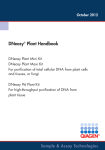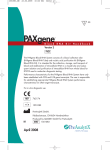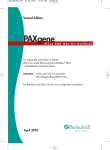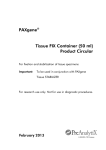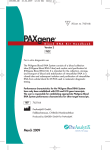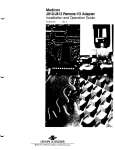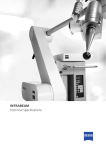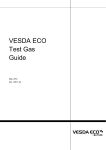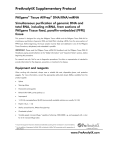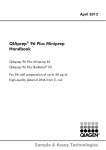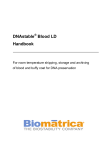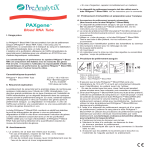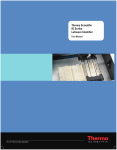Download PAXgene 96 Blood RNA Kit Handbook
Transcript
PAXgene® 96 Blood RNA Handbook For isolation of cellular RNA from whole blood Important: To be used only in conjunction with PAXgene Blood RNA tubes For research use only. Not for use in diagnostic procedures. February 2014 Trademarks: PAXgene®, PreAnalytiX® (PreAnalytiX GmbH); QIAGEN® (QIAGEN Group); BD Vacutainer®, DB Hemogard™, Safety-Lok™ (Becton, Dickinson and Company); Matrix® (Matrix Technologies Corporation); TaqMan® (Roche Group). Limited License Agreement for the PAXgene 96 Blood RNA Kit Use of this product signifies the agreement of any purchaser or user of the product to the following terms: 1. The product may be used solely in accordance with the protocols provided with the product and this handbook and for use with components contained in the kit only. PreAnalytiX grants no license under any of its intellectual property to use or incorporate the enclosed components of this kit with any components not included within this Kit except as described in the protocols provided with the product, this handbook, and additional protocols available at www.preanalytix.com. 2. Other than expressly stated licenses, PreAnalytiX makes no warranty that this kit and/or its use(s) do not infringe the rights of third-parties. 3. This kit and its components are licensed for one-time use and may not be reused, refurbished, or resold. 4. PreAnalytiX specifically disclaims any other licenses, expressed or implied other than those expressly stated. 5. The purchaser and user of the kit agree not to take or permit anyone else to take any steps that could lead to or facilitate any acts prohibited above. PreAnalytiX may enforce the prohibitions of this Limited License Agreement in any Court, and shall recover all its investigative and Court costs, including attorney fees, in any action to enforce this Limited License Agreement or any of its intellectual property rights relating to the Kit and/or its components. For updated license terms, see www.preanalytix.com. © 2014 PreAnalytiX GmbH, all rights reserved. PreAnalytiX PreAnalytiX GmbH Feldbachstrasse CH – 8634 Hombrechtikon Switzerland www.preanalytix.com PreAnalytiX Distributors PreAnalytiX® products are manufactured for PreAnalytiX by QIAGEN or BD and are distributed for PreAnalytiX by QIAGEN or BD. Products cannot be ordered at PreAnalytiX GmbH. Please see the last page for contact information for your local PreAnalytiX distributor. Contents Kit Contents 4 Shipping and Storage 5 Intended Use 5 Safety Information 5 Quality Control 6 Introduction 7 Principle and procedure Equipment and Reagents to Be Supplied by User Important Notes 7 9 10 QIAvac 96 vacuum manifold handling guidelines 10 Centrifugation 11 Protocol Isolation of RNA from Whole Blood Collected into PAXgene Blood RNA Tubes 14 Troubleshooting Guide 19 Appendix A: on-Plate DNase Digestion with the RNase-Free DNase Set 21 Appendix B: Quantification and Determination of Quality of Total RNA 22 Quantification of RNA 22 Purity of RNA 23 Appendix C: General Remarks on Handling RNA 24 Handling RNA 24 General handling 24 Appendix D: Handling PAXgene Blood RNA Tubes 25 Ordering Information 26 PreAnalytiX Worldwide 31 PAXgene 96 Blood RNA Handbook 02/2014 3 Kit Contents PAXgene® 96 Blood RNA Kit (4) Number of preps 762331 4 x 96 PAXgene 96 RNA Plates 4 PAXgene 96 Filter Plates 4 Buffer BR1 (resuspension buffer) 170 ml Buffer BR2 (binding buffer)* 220 ml Buffer BR3 (wash buffer)* 2 x 220 ml Buffer BR4 (wash buffer) 4 x 55 ml Buffer BR5 (elution buffer) RNase-free water Proteinase K RNase-Free DNase Set 60 ml 2 x 1000 ml 2 x 10 ml 8 x 50 reactions Round-Well Blocks 4 Square-Well Blocks 2 Rack of Collection Microtubes 4 Elution Microtube Racks 4 Caps for blocks and tubes Caps for Elution Microtubes AirPore Tape Sheets Secondary BD Hemogard™ Closures 2 x (55 x 8) 55 x 8 4x5 8 x 50 Register Cards (96-well) 4 Handbook 1 * Contains guanidine thiocyanate, which is not compatible with bleach. For safety information, see page 5. 4 PAXgene 96 Blood RNA Handbook 02/2014 Shipping and Storage Except for the RNase-Free DNase Set, the remaining components of the PAXgene 96 Blood RNA Kit can be stored at room temperature (18–25°C). The PAXgene 96 Blood RNA Kit contains ready-to-use proteinase K solution that is stable for at least 1 year after delivery when stored at room temperature. To store for more than 1 year, we suggest keeping the proteinase K at 2–8°C. The QIAGEN® RNase-Free DNase Set is shipped at room temperature. All components should be stored immediately upon receipt at 2–8°C. When stored at 2–8°C and handled correctly, the buffers and the lyophilized enzyme can be kept for at least 9 months without showing any reduction in performance. Intended Use For research use only. Not for use in diagnostic procedures. No claim or representation is intended to provide informationfor the diagnosis, prevention, or treatment of a disease. All due care and attention should be exercised in the handling of the products. We recommend all users of QIAGEN products to adhere to the NIH guidelines that have been developed for recombinant DNA experiments, or to other applicable guidelines. Safety Information When working with chemicals, always wear a suitable lab coat, disposable gloves, and protective goggles. For more information, please consult the appropriate safety data sheets (SDSs). These are available online in a convenient and compact PDF format at www.qiagen.com/Safety, where you can find, view, and print the SDS for each PreAnalytiX kit and kit component. CAUTION: DO NOT add bleach or acidic solutions directly to the sample-preparation waste. Buffer BR2 contains guanidine thiocyanate, which can form highly reactive compounds when combined with bleach. If liquid containing this buffer is spilt, clean with suitable laboratory detergent and water. If the spilt liquid contains potentially infectious agents, clean the affected area first with laboratory detergent and water, and then with 1% (v/v) sodium hypochlorite. PAXgene 96 Blood RNA Handbook 02/2014 5 The RNA stabilization solution and blood mixture from the PAXgene Blood RNA Tube must be disinfected by using 1 volume of commercial bleach solution (5% sodium hypochlorite) per 9 volumes of RNA stabilization and blood mixture. Sample-preparation waste, such as supernatants from centrifugation steps in the RNA purification procedure, is to be considered potentially infectious. Before disposal, the waste must be autoclaved or incinerated to destroy any infectious material. Disposal must be made according to official regulations. 24-hour emergency information Chemical emergency or accident assistance is available 24 hours a day from: CHEMTREC USA & Canada Tel: 1-800-424-9300 Outside USA & Canada Tel: +1-703-527-3887 (collect calls accepted) Quality Control In accordance with QIAGEN’s ISO-certified Total Quality Management System, each lot of PAXgene 96 Blood RNA Kits is tested against predetermined specifications to ensure consistent product quality. 6 PAXgene 96 Blood RNA Handbook 02/2014 Introduction The PAXgene 96 Blood RNA Kit allows the high-throughput isolation of total RNA from 2.5 ml human whole blood collected into PAXgene Blood RNA Tubes. Principle and procedure The simple isolation procedure begins with a centrifugation step to pellet the contents of each PAXgene Blood RNA Tube. Each pellet is washed, resuspended, and incubated in optimized buffers together with proteinase K to digest proteins. Lysates are applied to a PAXgene 96 Filter Plate and centrifuged to remove residual cell debris (see flowchart, next page). Ethanol is added to the flow-through to adjust binding conditions, and the lysates are applied to a PAXgene 96 RNA Plate. RNA is selectively bound to the PAXgene 96 RNA membrane as contaminants pass through. Residual DNA is removed through a DNase I digestion on the PAXgene 96 membrane. Remaining contaminants are removed in three efficient wash steps and RNA is eluted in Buffer BR5. A final heat treatment of the eluate enhances performance in downstream applications. Typical yields of RNA isolated from 2.5 ml human whole blood are between 4 and 20 μg. However, the yield is donor-dependent, and in some cases higher or lower yields may be achieved. The purified RNA is ready for immediate use. Downstream applications that use RNA include RT-PCR, cDNA synthesis, and quantitative RT-PCR (including TaqMan® technology). PAXgene 96 Blood RNA Handbook 02/2014 7 8 PAXgene 96 Blood RNA Handbook 02/2014 Equipment and Reagents to Be Supplied by User When working with chemicals, always wear a suitable lab coat, disposable gloves, and protective goggles. For more information, consult the appropriate safety data sheets (SDSs), available from the product supplier. PAXgene Blood RNA Tubes (PreAnalytiX, cat. no. 762165) Multichannel pipet with tips. For efficient liquid handling, we recommend usingan electric multichannel pipet with a minimum capacity of 650 μl per pipet tip. For example, Matrix Technologies Corporation (www.matrixtechcorp.com ) provides cordlesselectronic multichannel pipets with a unique expandable tip-spacing system,allowing transfer of liquid between different types of multiwell plate.* Reagent reservoirs for multichannel pipets Disposable gloves Square-Well Blocks (cat. no. 19573, optional)† 96–100% ethanol QIAvac 96 vacuum manifold Vacuum source capable of generating a vacuum pressure of –800 to –900 mbar Centrifuge 4–16S or Centrifuge 4–16KS Plate Rotor 2 x 96 PAXgene 96 Incubator Block (available from QIAGEN, contact QIAGEN Technical Services) * This is not a complete list of suppliers and does not include many important vendors of biological supplies. † Two Square-Well Blocks are supplied with the kit. They can be reused (see page 13). If several plates are processed per day, it may be convenient to have extra Square-Well Blocks available. PAXgene 96 Blood RNA Handbook 02/2014 9 Important Notes QIAvac 96 vacuum manifold handling guidelines Use of the convenient modular QIAvac 96 vacuum manifold facilitates RNA preps performed using the PAXgene 96 Blood RNA Kit. The following recommendations should be followed when handling the QIAvac 96 vacuum manifold. • QIAvac 96 operates with a vacuum pump. We recommend using a vacuum pump with a capacity of 18 liter/min. Use of insufficient vacuum pressure may reduce RNA yield and purity. • A vacuum pressure of –800 to –900 mbar should develop when a PAXgene 96 RNA Plate sealed with tape is used on the QIAvac 96. Vacuum pressures exceeding –900 mbar should be avoided. The vacuum pressure is the pressure differential between the inside of the manifold and the atmosphere (standard atmospheric pressure: 1013 mbar or 760 mm Hg) and can be regulated and measured using a pressure gauge or vacuum regulator. Vacuum recommendations are given in negative units to indicate the required reduction in pressure with respect to the atmosphere. Table 1 (page 12) provides pressure conversions to other units. • Between loading steps, the vacuum must be switched off and the manifold ventilated to maintain uniform conditions for each sample. This can be done with a vacuum regulator inserted between the vacuum source and the QIAvac 96 vacuum manifold. • Wear safety glasses when working near a manifold under pressure. • Always place the PAXgene 96 RNA Plate into the vacuum manifold with the beveled edges pointing to the right-hand side. For safety reasons, do not use plates that have been damaged in any way. • Always place the QIAvac 96 vacuum manifold on a secure bench top or work area. If dropped, the manifold may crack. • Always store the QIAvac 96 vacuum manifold clean and dry. To clean, simply rinse all components with water, and dry with paper towels. Do not air dry, as the screws may rust and need to be replaced. Do not use abrasives. Finally, wipe manifold components with paper towels wetted with 70% ethanol, and dry with fresh paper towels. 10 PAXgene 96 Blood RNA Handbook 02/2014 • The QIAvac 96 vacuum manifold and components are not resistant to ethanol, methanol, or other organic solvents when exposed for long periods. If solvents are spilled on the unit, rinse thoroughly with distilled water after the completion of the procedure. Ensure that no residual buffers remain in the vacuum manifold. • To ensure consistent performance, do not apply silicone or vacuum grease to any part of the QIAvac 96 vacuum manifold. The spring lock on the top plate and the self-sealing gasket provide an airtight seal when the vacuum is applied to the assembled unit. To maximize gasket life, rinse the gasket free of salts and buffers after each use, and dry with paper towels before storage. Table 1. Pressure conversions To convert from millibars (mbar) to: Multiply by: Millimeters of mercury (mm Hg) 0.75 Kilopascals (kPa) 0.1 Inches of mercury (inch Hg) 0.0295 Torrs (Torr) 0.75 Atmospheres (atmos) 0.000987 Pounds per square inch (psi) 0.0145 Centrifugation The PAXgene 96 Blood RNA protocol utilizes a streamlined centrifugation procedure that allows preparation of RNA from up to 2 x 96 samples in parallel for direct use in downstream applications. For optimal handling, QIAGEN, in cooperation with the centrifuge manufacturer Sigma Laborzentrifugen GmbH, has developed a centrifugation system consisting of the Plate Rotor 2 x 96, and the table-top Centrifuge 4–16S or Centrifuge 4–16KS . A wide range of other rotors can be used with Centrifuge 4–16S or Centrifuge 4–16KS in addition to the Plate Rotor 2 x 96. Standard table-top centrifuges and 96-well–microplate rotors are not suitable for the PAXgene 96 Blood RNA procedure. Usually 96-well–microplate buckets are not deep enough to carry the complete PAXgene assembly without interfering with how the buckets swing out. Furthermore, high g-forces (>5500 x g) are required for optimal performance of the PAXgene 96 Blood RNA Kit. For further information about the centrifuges and Plate Rotor 2 x 96 please contact QIAGEN. PAXgene 96 Blood RNA Handbook 02/2014 11 Abbreviated instructions for using the Centrifuge 4–16S and the Centrifuge 4–16KS 1. Switch on the centrifuge by pressing the main switch on the back. 2. Select the rotor selection list in the display field by turning the knob. Press the knob and turn it again to select the rotor/bucket combination “09100/09158” for the Plate Rotor 2 x 96. Confirm entry by pressing the knob. Entering the rotor number automatically sets the time and speed limits for centrifugation for that particular rotor, eliminating the danger of the centrifuge running too fast. 3. Select “Speed” by turning the knob. Press the knob and turn it again to set the speed to “6000”. Confirm entry by pressing the knob. The corresponding relative centrifugal force (RCF) is calculated from the rotor number and speed and appears automatically in the RCF field. It is also possible to enter the RCF value “5788 x g” manually in the RCF field after selecting “RCF” in the same way. 4. Select “Time” by turning the knob. Press once and turn the knob again to set the time as required. Confirm entry by pressing the knob. 5. Open the lid, place the 96-well plates with the metal carriers in the buckets, and close the lid. The start and lid keys light up. 6. Push “Start” to start the centrifuge. When the centrifuge is running, the lid key will not be lit. Each run can be interrupted by pushing “Stop”. 7. At the end of the run, the lid key will light up. Open the centrifuge lid by pressing the lid key. Remove the plates. All preset parameters remain after a run has finished. Warning: Do not centrifuge the Plate Rotor 2 x 96 metal holders without the PAXgene 96 RNA Plates and Square-Well Blocks or elution microtubes. If unsupported, the holders will collapse under high g-force. Remove the holders during test runs. Standard 96-well microplates may be centrifuged in the holders if the g-force of 500 x g is not exceeded. 12 PAXgene 96 Blood RNA Handbook 02/2014 Square-Well Blocks Two Square-Well Blocks are supplied per kit. If several PAXgene 96 RNA Plates are processed per day, it may be convenient to have extra Square-Well Blocks available. To reuse the Square-Well Blocks, rinse them thoroughly with tap water, incubate for 2 hours or overnight in 0.1 N NaOH/1 mM EDTA, rinse in distilled water, and dry at 50°C. Note: Do not use bleach. PAXgene 96 Blood RNA Handbook 02/2014 13 Protocol: Isolation of RNA from Whole Blood Collected into PAXgene Blood RNA Tubes Important points before starting • Blood must be collected in PAXgene Blood RNA Tubes (cat. no. 762165). • After collection of the blood sample, it is important to incubate the PAXgene Blood RNA Tube for at least 2 hours at room temperature (18–25°C) before RNA purification. Incubation of the PAXgene Blood RNA Tube overnight may increase yields in some cases. • Use of a multichannel pipet is recommended. Pour buffers into reagent reservoirs for multichannel pipets. Use reservoirs from a freshly opened package or clean them as described for Square-Well Blocks (see page 13). • A vacuum source capable of generating a vacuum pressure of –800 to –900 mbar is necessary for the protocol. The vacuum must be switched off and the manifold ventilated between pipetting steps to maintain uniform conditions for each sample. • All steps of the PAXgene 96 Blood RNA protocol for isolation of total RNA should be performed at room temperature. Avoid interruptions during the procedure. • All centrifugation steps in the protocol are performed in a Centrifuge 4–16S or Centrifuge 4–16KS (see page 11). Things to do before starting • Buffer BR2 may form a precipitate upon storage. If necessary, warm to 37°C to redissolve. • Buffer BR4 is supplied as a concentrate. Before using for the first time, add 4 volumes of ethanol (96–100%) to obtain a working solution. • Heat an incubator to 65°C for the proteinase K digestion step. • If one incubator is used for the entire procedure, set the temperature to 80°C after the proteinase K digestion to heat up in time for the final heat denaturation step. Place the PAXgene 96 Incubator Block into the incubator. • Prepare DNase I for the on-plate DNase digest in step 16 according to the protocol in the appendix (page 21). Procedure 1. Place the waste tray inside the QIAvac 96 base and place the top plate squarely over the base. 14 PAXgene 96 Blood RNA Handbook 02/2014 2. Place the PAXgene 96 RNA Plate in the QIAvac 96 top plate, making sure that the plate is seated tightly. 3. Attach the QIAvac 96 manifold to the vacuum source. Note: Keep the vacuum switched off. Note: Always place the PAXgene 96 RNA Plate into the vacuum manifold with the beveled edge pointing to the right-hand side. 4. Centrifuge the PAXgene Blood RNA Tube for 10 min at 3000–5000 x g using a swing-out rotor. Note: The tube adaptors need to be round bottomed. Tubes may break during centrifugation if centrifuge adaptors with conical bottoms are used. 5. Remove the supernatant by decanting or pipetting. Add 4 ml RNasefree water to the pellet, and close the tube using a fresh Secondary BD Hemogard Closure. If the supernatant is decanted, dry the rim of the tube with a clean paper towel. 6. Thoroughly resuspend the pellet by vortexing and centrifuge for 10 min at 3000–5000 x g. Remove and discard the entire supernatant. Small amounts of debris remaining in the supernatant after vortexing will not affect the procedure. If the supernatant is decanted, dry the rim of the tube with a clean paper towel. Note: Incomplete removal of the supernatant will dilute the lysate and inhibit lysis, which will affect the binding conditions. 7. Thoroughly resuspend the pellet in 350 μl Buffer BR1 and transfer to a Round-Well Block. Transfer all samples to the Round-Well Block before adding proteinase K or Buffer BR2. 8. Add 40 μl Proteinase K and 300 μl Buffer BR2 to all samples in the Round-Well Block. Seal the wells of the Round-Well Block with the appropriate caps and shake the Round-Well Block vigorously for 10 s upside down. Incubate the Round-Well Block for 30 min at 65°C in an incubator. Place a heavy plate over the caps to prevent them from popping open. Shake once during the incubation. Note: It is essential to mix the sample thoroughly to achieve optimal protein digestion. Insufficient mixing can reduce RNA yield. If one incubator is used for the entire procedure, set the incubator to 80°C after the proteinase digestion for it to heat up in time for the final heat denaturation step. Place the PAXgene 96 Incubator. Block into the incubator. Do not mix Buffer BR2 and proteinase K together before adding them to the sample. PAXgene 96 Blood RNA Handbook 02/2014 15 9. Briefly centrifuge the block (10 s) at <1000 x g. Do not exceed the centrifugation time, as longer centrifugation can lead to pellet formation. 10. Transfer the samples to a PAXgene 96 Filter Plate sitting on a rack of collection microtubes. Mark the PAXgene 96 Filter Plate and collection microtube rack for later identification. Note: Set the multichannel pipet to 850 μl to transfer the entire sample to the PAXgene 96 Filter Plate. 11. Seal the PAXgene 96 Filter Plate with an AirPore Tape Sheet, load the collection microtube rack and PAXgene 96 Filter Plate into the holder of the plate rotor and place the whole assembly into the rotor bucket. 12. Centrifuge at 6000 rpm (~5600 x g) for 10 min at room temperature (18–25°C). 13. Remove and discard the PAXgene 96 Filter Plate. Add 350 μl 100% ethanol to each collection microtube and mix by pipetting up and down 3 times. 14. Pipet complete samples (1040 μl) into the wells of the PAXgene 96 RNA Plate. Apply vacuum until transfer is complete (15–60 s). Switch off vacuum, and ventilate the QIAvac 96 manifold. Mark the PAXgene 96 RNA Plate for later identification. Set the multichannel pipet to 1200 μl to transfer the entire sample to the PAXgene 96 RNA Plate. Make sure the QIAvac 96 vacuum manifold is assembled correctly before loading. The flow-through is collected in the waste tray. Note: Cover unused wells with adhesive tape. Do not use the AirPore Tape Sheets supplied with the PAXgene 96 Blood RNA Kit. Use either adhesive tape or Tape Pads (QIAGEN, cat. no. 19570). Note: The vacuum must be switched off and the manifold ventilated between pipetting steps to maintain uniform conditions for each sample. 15. Add 500 μl Buffer BR3 to each well of the PAXgene 96 RNA Plate. Switch on the vacuum source, and apply vacuum until transfer is complete (15–60 s). Switch off the vacuum, and ventilate the QIAvac 96 manifold. Collect wash fractions in the same waste tray used in step 14. 16 PAXgene 96 Blood RNA Handbook 02/2014 16. Pipet 80 μl of the DNase I incubation mix (see “Things to do before starting”, page 14) directly onto the PAXgene membrane in each well of the PAXgene 96 RNA Plate. Seal the plate with an AirPore Tape Sheet. Incubate at room temperature for 15 min. Note: Be sure to pipet the DNase I incubation mix directly onto the center of the PAXgene membrane. DNase digestion will be incomplete if some of the mix sticks to the walls or the O-rings of the PAXgene 96 RNA Plate. 17. Remove the AirPore Tape and add 500 μl Buffer BR3 to each well of the PAXgene 96 RNA Plate. Apply vacuum until transfer is complete (15–60 s). Switch off the vacuum, and ventilate the QIAvac 96 manifold. Collect wash fractions in the same waste tray used in step 14. 18. Lift the top plate carrying the PAXgene 96 RNA Plate from the base, and empty the waste tray. Reassemble the QIAvac 96 vacuum manifold. 19. Add 1 ml of Buffer BR4 to each well of the PAXgene 96 RNA Plate. Apply vacuum until transfer is complete (10–30 s). Switch off the vacuum, and ventilate the QIAvac 96 manifold. Note: Ensure that ethanol is added to Buffer BR4 (see “Things to do before starting” on page 14). 20. Place the PAXgene 96 RNA Plate on top of a Square-Well Block. 21. Add a further 1 ml Buffer BR4 to each well of the PAXgene 96 RNA Plate. Load the Square-Well Block and PAXgene 96 RNA Plate into the holder of the plate rotor, and place the whole assembly in the rotor bucket. Centrifuge at 6000 rpm (~5600 x g) for 10 min at room temperature to allow Buffer BR4 to pass through and to dry the membranes. Important: Ensure that the centrifuge is properly balanced. Note: It is important to dry the PAXgene membranes since residual ethanol may interfere with subsequent reactions. The 10 min centrifugation ensures that residual traces of salt are removed and that no ethanol is carried over during elution. 22. Place the PAXgene 96 RNA Plate on top of a clean elution microtubes rack. To elute the RNA, add 45–60 μl Buffer BR5 to each well, and seal the PAXgene 96 RNA Plate with a new sheet of AirPore Tape. Incubate for 1 min at room temperature. Then centrifuge at 6000 rpm (~5600 x g) for 4 min. Note: Be sure to pipet the Buffer BR5 directly onto the center of the PAXgene membrane. Elution will be incomplete if some of the buffer sticks to the walls or the O-rings of the PAXgene 96 RNA Plate. PAXgene 96 Blood RNA Handbook 02/2014 17 23. Remove the AirPore Tape. Repeat step 22 once with a second 45–60 μl Buffer BR5. Note: Repeating the elution step is required for complete recovery of RNA. The elution volume will be approximately 15 μl less (membrane dead volume) than the volume of Buffer BR5 added to the membrane. 24. Remove the PAXgene 96 RNA Plate and seal the elution microtubes with the appropriate caps. 25. Remove the bottom plate from the elution microtube rack using a scalpel or spatula. Place the elution microtube rack onto the PAXgene 96 Incubator Block preheated in the 80°C incubator, and incubate for 10 min at 80°C. Place a heavy plate over the caps to prevent them from popping open. Following incubation, chill immediately on ice. Put the bottom plate back onto the rack for storage. Store the purified RNA at –20°C or –70°C. Denaturation of the eluate is essential for maximum efficiency in some downstream applications, such as RT-PCR, other amplification reactions, or cDNA synthesis. It is not necessary to denature samples more than once, and samples remain denatured after freezing and thawing. For accurate quantification of RNA by absorbance at 260 nm, we recommend dilution of the sample in 10 mM Tris·Cl, pH 7.5. Dilution of the sample in RNase-free water may lead to inaccurately low values. For accurate quantification of RNA by absorbance at 260 nm, we recommend diluting the sample in 10 mM Tris·Cl, pH 7.5.* Dilution of the sample in RNase-free water may lead to inaccurately low values. Use the buffer in which the RNA is diluted to zero the spectrophotometer, and make sure to add the same volume of elution buffer (Buffer BR5) as the volume of eluted RNA to be diluted. Elution buffer (Buffer BR5) has high absorbance at 220 nm, which can lead to high background absorbance levels if the spectrophotometer is not properly zeroed. Note: For quantification in Tris buffer, use the relationship A260 = 1 44 μg/ml. * When working with chemicals, always wear a suitable lab coat, disposable gloves, and protective goggles. For more information, consult the appropriate safety data sheets (SDSs), available from the product supplier. 18 PAXgene 96 Blood RNA Handbook 02/2014 Troubleshooting Guide This troubleshooting guide may be helpful in solving any problems that may arise. For more information, see also the Frequently Asked Questions page at our Technical Support Center: www.qiagen.com/FAQ/FAQList.aspx. The scientists in QIAGEN Technical Services are always happy to answer any questions you may have about the information and protocol in this handbook or sample and assay technologies (for contact information, see the last page or visit www.qiagen.com). Comments and suggestions RNA degraded RNase contamination Check for RNase contamination of buffers. Although all buffers have been tested and are guaranteed RNase-free, RNases can be introduced during use. Be careful not to introduce any RNases during the procedure or later handling RNA does not perform well in downstream experiments a) Salt carryover during elution Ensure that Buffer BR4 is at room temperature (18–25°C). b) Ethanol carryover Ensure that during the second wash with Buffer BR4, plates are centrifuged at 6000 rpm for 10 min to dry the membranes. c) No incubation of the RNA eluate at 80°C Ensure that incubation of the eluate at 80°C is performed in the alloy block. Low RNA yield a) Less than 2.5 ml blood collected in the PAXgene Blood RNA Tube Ensure that 2.5 ml blood is collected in the PAXgene Blood RNA Tube (see Product Circular for the PAXgene Blood RNA Tube). b) RNA concentration measured in water RNA concentration must be measured in 10 mM Tris·Cl, pH 7.5 for accurate quantification. c) Supernatant not completely removed in step 5 Ensure the entire supernatant is removed. If the supernatant is decanted, remove drops from the rim of the tube by dabbing onto a paper towel. PAXgene 96 Blood RNA Handbook 02/2014 19 Comments and suggestions d) Blood incubated for <2 h after collection Incubate blood in the PAXgene Blood RNA Tube for at least 2 h after collection. Incubation of the PAXgene Blood RNA Tube overnight may increase yields slightly in some cases. Low A260/A280 a) RNA purity measured in water Use 10 mM Tris·Cl, pH 7.5, to dilute RNA before measuring purity. b) Spectrophotometer not properly zeroed To zero the spectrophotometer, use a blank containing the same proportion of elution buffer (Buffer BR5) and dilution buffers as in the samples to be measured. Buffer BR5 has high absorbance at 220 nm, which can lead to high background absorbance levels if the spectrophotometer is not properly zeroed. 20 PAXgene 96 Blood RNA Handbook 02/2014 Appendix A: On-Plate DNase Digestion with the RNase-Free DNase Set The RNase-Free DNase Set from QIAGEN provides on-plate digestion of DNA during RNA purification. The DNase is removed in subsequent wash steps. Note: Standard DNase buffers are not compatible with on-membrane DNase digestion. Use of other buffers may affect the binding of the RNA to the PAXgene membrane, reducing the yield and integrity of the RNA. After washing with Buffer BR3, the RNA is treated with DNase I while bound to the silica-gel membrane. The DNase is removed by a second wash with Buffer BR3. Washing with Buffer BR4 and elution are then performed according to the protocol. One RNase-Free DNase Set contains RNase-free reagents and buffers for 50 RNA preps. • Prepare DNase I stock solution before using the RNase-Free DNase Set for the first time. Dissolve the solid DNase I (1500 Kunitz units) in 550 μl RNasefree water (provided). • Take care that no DNase I is lost when opening the vial. Note: DNase I is especially sensitive to physical denaturation. Mixing should only be carried out by gently flicking or inverting the tube. Do not vortex. • For each sample to be processed, add 10 μl DNase I stock solution to 70 μl Buffer RDD. • Processing of multiple samples: For 48 samples, dissolve the solid DNase I (1500 Kunitz units) in 550 μl RNase-free water to make a stock solution. Add 3850 μl Buffer RDD. Mix by gently flicking the tube, and centrifuge briefly to collect residual liquid from the sides of the tube. For 96 samples, dissolve two sets of DNase I in 550 μl RNase-free water each. Pool the stock solutions and add 7700 μl Buffer RDD. Mix by gently flicking the tube, and centrifuge briefly to collect residual liquid from the sides of the tube. Buffer RDD is supplied with the RNase-Free DNase Set. • For long-term storage of DNase I, divide the stock solution into single-use aliquots, and store at –20°C for up to 9 months. Thawed aliquots can be stored at 2–8°C for up to 6 weeks. Do not refreeze the aliquots after thawing. PAXgene 96 Blood RNA Handbook 02/2014 21 Appendix B: Quantification and Determination of Quality of Total RNA Quantification of RNA The concentration of RNA should be determined by measuring the absorbance at 260 nm (A260) in a spectrophotometer. To ensure significance, readings should be in the linear range of the spectrophotometer. An absorbance of 1 unit at 260 nm corresponds to 44 μg of RNA per ml (A260 = 1 44 μg/ml). This relation is valid only for measurements in 10 mM Tris·Cl,* pH 7.5. Therefore, if it is necessary to dilute the RNA sample, this should be done in 10 mM Tris·Cl. As discussed (see ”Purity of RNA” below), the ratio between the absorbance values at 260 and 280 nm gives an estimate of RNA purity. When measuring RNA samples, be certain that cuvettes are RNase-free. Use the buffer in which the RNA is diluted to zero the spectrophotometer, and make sure to add the same volume of Buffer BR5 as the volume of eluted RNA to be diluted. Buffer BR5 has high absorbance at 220 nm, which can lead to high background absorbance levels if the spectrophotometer is not properly zeroed. An example of the calculation involved in RNA quantification is shown below: Volume of RNA sample = 120 μl Dilution = 10 μl of RNA sample + 140 μl 10 mM Tris·Cl, pH 7.5 (1/15 dilution) Measure absorbance of diluted sample in a cuvette (RNase-free). A260 = 0.2 Concentration of RNA sample = 44 x A260 x dilution factor = 44 x 0.2 x 15 = 132 μg/ml Total yield = concentration x volume of sample in milliliters = 132 μg/ml x 0.12 ml = 15.8 μg RNA * When working with chemicals, always wear a suitable lab coat, disposable gloves, and protective goggles. For more information, consult the appropriate safety data sheets (SDSs), available from the product supplier. 22 PAXgene 96 Blood RNA Handbook 02/2014 Purity of RNA The ratio of the readings at 260 nm and 280 nm (A260/A280) provides an estimate of the purity of RNA with respect to contaminants that absorb UV light, such as protein. However, the A260/A280 ratio is influenced considerably by pH. Lower pH results in a lower A260/A280 ratio and reduced sensitivity to protein contamination.* For accurate values, we recommend measuring absorbance in 10 mM Tris·Cl, pH 7.5. Pure RNA has an A260/A280 ratio of 1.8–2.2 in 10 mM Tris·Cl, pH 7.5. Use the buffer in which the RNA is diluted to zero the spectrophotometer, and make sure to add the same volume of Buffer BR5 as the volume of eluted RNA to be diluted. Buffer BR5 has high absorbance at 220 nm, which can lead to high background absorbance levels if the spectrophotometer is not properly zeroed. * Wilfinger, W. W., Mackey, M., and Chomczynski, P. (1997) Effect of pH and ionic strength on the spectrophotometric assessment of nucleic acid purity. BioTechniques 22, 474. PAXgene 96 Blood RNA Handbook 02/2014 23 Appendix C: General Remarks on Handling RNA Handling RNA Ribonucleases (RNases) are very stable and active enzymes that generally do not require cofactors to function. Since RNases are difficult to inactivate and even minute amounts are sufficient to destroy RNA, do not use any plasticware or glassware without first eliminating possible RNase contamination. Great care should be taken to avoid inadvertently introducing RNases into the RNA sample during or after the purification procedure. To create and maintain an RNasefree environment, precautions must be taken during pretreatment and use of disposable and non-disposable vessels and solutions while working with RNA. General handling Proper microbiological, aseptic technique should always be used when working with RNA. Hands and dust particles carry bacteria and molds and are the most common sources of RNase contamination. Always wear latex or vinyl gloves while handling reagents and RNA samples to prevent RNase contamination from the surface of the skin or from dusty laboratory equipment. Change gloves frequently and keep tubes closed whenever possible. Keep purified RNA on ice when aliquots are pipetted for downstream applications. Protocols for removing RNase-contamination from glassware and solutions can be found in general molecular biology guides, such as Sambrook, J. and Russell, D. W. (2001) Molecular Cloning: A Laboratory Manual, 3rd ed. Cold Spring Harbor, NY: Cold Spring Harbor Laboratory Press. 24 PAXgene 96 Blood RNA Handbook 02/2014 Appendix D: Handling PAXgene Blood RNA Tubes The following recommendations from BD may be helpful when handling PAXgene Blood RNA Tubes. See the PAXgene Blood RNA Tube Product Circular for more information about PAXgene Blood RNA Tubes. Instructions for removal of BD Hemogard Closure D1. Grasp the PAXgene Blood RNA Tube with one hand, placing the thumb under the BD Hemogard Closure. (For added stability, place arm on solid surface.) With the other hand, twist the BD Hemogard Closure while simultaneously pushing up with the thumb of the other hand ONLY UNTIL THE TUBE STOPPER IS LOOSENED. D2. Move thumb away before lifting closure. DO NOT use thumb to push closure off tube. Caution: If the tube contains blood, an exposure hazard exists. To help prevent exposure during closure removal, it is important that the thumb used to push upward on the closure be removed from contact with the tube as soon as the BD Hemogard Closure is loosened. D3. Lift closure off tube. In the unlikely event of the plastic shield separating from the rubber stopper, DO NOT REASSEMBLE CLOSURE. Carefully remove rubber stopper from tube. Instructions for insertion of Secondary BD Hemogard Closure D1. Replace closure over tube. D2. Twist and push down firmly until stopper is fully reseated. Complete reinsertion of the stopper is necessary for the closure to remain securely on the tube during handling. PAXgene 96 Blood RNA Handbook 02/2014 25 Ordering Information Product Contents Cat. no. PAXgene 96 Blood RNA Kit (4) 4 PAXgene 96 RNA Plates, 4 PAXgene 96 Filter Plates, Buffers, Proteinase K, RNase-free DNase Set, AirPore Tape Sheets, Collection Vessels. To be used in conjunction with PAXgene Blood RNA Tubes 762331 Related products Products that can be ordered from BD and BD authorized distributors‡ PAXgene Blood RNA Tubes (100) 100 Blood Collection Tubes. To be used in conjunction with the PAXgene Blood RNA Kit (50) 762165 Blood Collection Set BD Vacutainer® Safety-Lok™ Blood Collection Set: 21G, 0.75 inch needle, 12 inch tubing with luer adapter; 50 per box, 200 per case 367286 BD Vacutainer OneUse Holder Case only for 13 mm and 16 mm diameter; 1000/case 364815 BD Vacutainer Plus Serum Tubes 13 x 75 mm 4.0 ml draw with Red BD Hemogard Closure and paper label; 100/box, 1000/case 368975 Vacuum manifold for processing QIAGEN 96-well plates: includes QIAvac 96 Top Plate, Base, Waste Tray, Plate Holder, Rack of Collection Microtubes (1.2 ml) 19504 Accessories QIAvac 96 26 PAXgene 96 Blood RNA Handbook 02/2014 Centrifuge 4–16S Universal laboratory centrifuge with brushless motor 81500*; 81510†; 81525‡; 81520§ Centrifuge 4–16KS Refrigerated universal laboratory centrifuge with brushless motor 81600*; 81610†; 81625‡; 81620§ Plate Rotor 2 x 96 Rotor for 2 QIAGEN 96-well plates, for use with QIAGEN Centrifuges 81031 Vacuum Regulator For use with QIAvac manifolds 19530 Square-Well Blocks 96-well blocks with 2.2 ml wells, 24 per case 19573 PAXgene 96 Incubator Block Block for incubating eluates in PAXgene 96 procedures 9238279 For up-to-date licensing information and product-specific disclaimers, see the respective PreAnalytiX or QIAGEN kit handbook or user manual. PreAnalytiX and QIAGEN kit handbooks and user manuals are available at www.qiagen.com or can be requested from QIAGEN Technical Services or your local distributor. * Japan. North America. ‡ UK. § Rest of World. † PAXgene 96 Blood RNA Handbook 02/2014 27 Notes 28 PAXgene 96 Blood RNA Handbook 02/2014 Notes PAXgene 96 Blood RNA Handbook 02/2014 29 Notes 30 PAXgene 96 Blood RNA Handbook 02/2014 PreAnalytiX Worldwide PreAnalytiX products are distributed by QIAGEN and BD companies Australia• Orders 1-800-243-800 • Fax 03-9840-9888 • Technical 1-800-243-066 Austria• Orders 0800-28-10-10 • Fax 0800-28-10-19 • Technical 0800-28-10-11 Belgium• Orders 0800-79612 • Fax 0800-79611 • Technical 0800-79556 Brazil• Orders 0800-557779 • Fax 55-11-5079-4001 • Technical 0800-557779 Canada• Orders 800-572-9613 • Fax 800-713-5951 • Technical 800-DNA-PREP (800-362-7737) China• Orders 86-21-3865-3865 • Fax 86-21-3865-3965 • Technical 800-988-0325 Denmark• Orders 80-885945 • Fax 80-885944 • Technical 80-885942 Finland• Orders 0800-914416 • Fax 0800-914415 • Technical 0800-914413 France• Orders 01-60-920-926 • Fax 01-60-920-925 • Technical 01-60-920-930 • Offers 01-60-920-928 Germany• Orders 02103-29-12000 • Fax 02103-29-22000 • Technical 02103-29-12400 Hong Kong• Orders 800 933 965 • Fax 800 930 439 • Technical 800 930 425 Ireland• Orders 1800 555 049 • Fax 1800 555 048 • Technical 1800 555 061 Italy• Orders 800-789-544 • Fax 02-334304-826 • Technical 800-787980 Japan• Telephone 03-6890-7300 • Fax 03-5547-0818 • Technical 03-6890-7300 Korea (South) • Orders 080-000-7146 • Fax 02-2626-5703 • Technical 080-000-7145 Luxembourg• Orders 8002-2076 • Fax 8002-2073 • Technical 8002-2067 Mexico• Orders 01-800-7742-639 • Fax 01-800-1122-330 • Technical 01-800-7742-436 The Netherlands• Orders 0800-0229592 • Fax 0800-0229593 • Technical 0800-0229602 Norway• Orders 800-18859 • Fax 800-18817 • Technical 800-18712 Singapore• Orders 1800-742-4362 • Fax 65-6854-8184 • Technical 1800-742-4368 Spain• Orders 91-630-7050 • Fax 91-630-5145 • Technical 91-630-7050 Sweden• Orders 020-790282 • Fax 020-790582 • Technical 020-798328 Switzerland• Orders 055-254-22-11 • Fax 055-254-22-13 • Technical 055-254-22-12 UK• Orders 01293-422-911 • Fax 01293-422-922 • Technical 01293-422-999 USA• Orders 800-426-8157 • Fax 800-718-2056 • Technical 800-DNA-PREP (800-362-7737) www.qiagen.com www.PreAnalytiX.com Argentina, Uruguay and Paraguay • Orders 011 4551 7100 Australia • Orders 1 800 656 100 • Fax 1 800 656 110 Austria • Orders 43 1 7063660 • Fax 43 1 7063660-11 Belgium • Orders 32-53720408 • Fax 32-53720558 Brazil • Orders 0800 055 5654 Canada • Orders 800-268-5430 • Fax 800-565-0897 Denmark • Orders 45 43 43-45-66 • Fax 45 43-43-41-66 East Europe, Middle East &Africa (EMA) • Orders 971 4 3379525 • Fax: 971 4 03379551 Finland • Orders 358-9-88-70-780 • Fax 358-9-88-70-7817 France • Orders 33 476 683636 • Fax 33 476 683693 Germany • Orders 49 6221305553 • Fax 49 6221305377 Italy • Orders 390248204775 • Fax 390248204817 • Technical 390248240264 The Netherlands• Orders 31 20 6545 716 • Fax 31 20 5829 421 New Zealand • Orders 0800 572 468 • Fax 0800 572 469 Spain • Orders 34-91-848-8115 • Fax 34-91-848-8104 Sweden • Orders 46 8 775 51 00 • Fax 46 8 775 51 95 Switzerland • Orders 41 61 4852222 • Fax 41 61 4852200 UK • Orders 44 1-865-781-666 • Fax 44 1-865-781-528 USA • Orders 888-237-2762 • Fax 800-847-2220 • Technical 800-631-0174 www.bd.com PAXgene 96 Blood RNA Handbook 02/2014 www.PreAnalytiX.com 31 1078550 02/2014
































